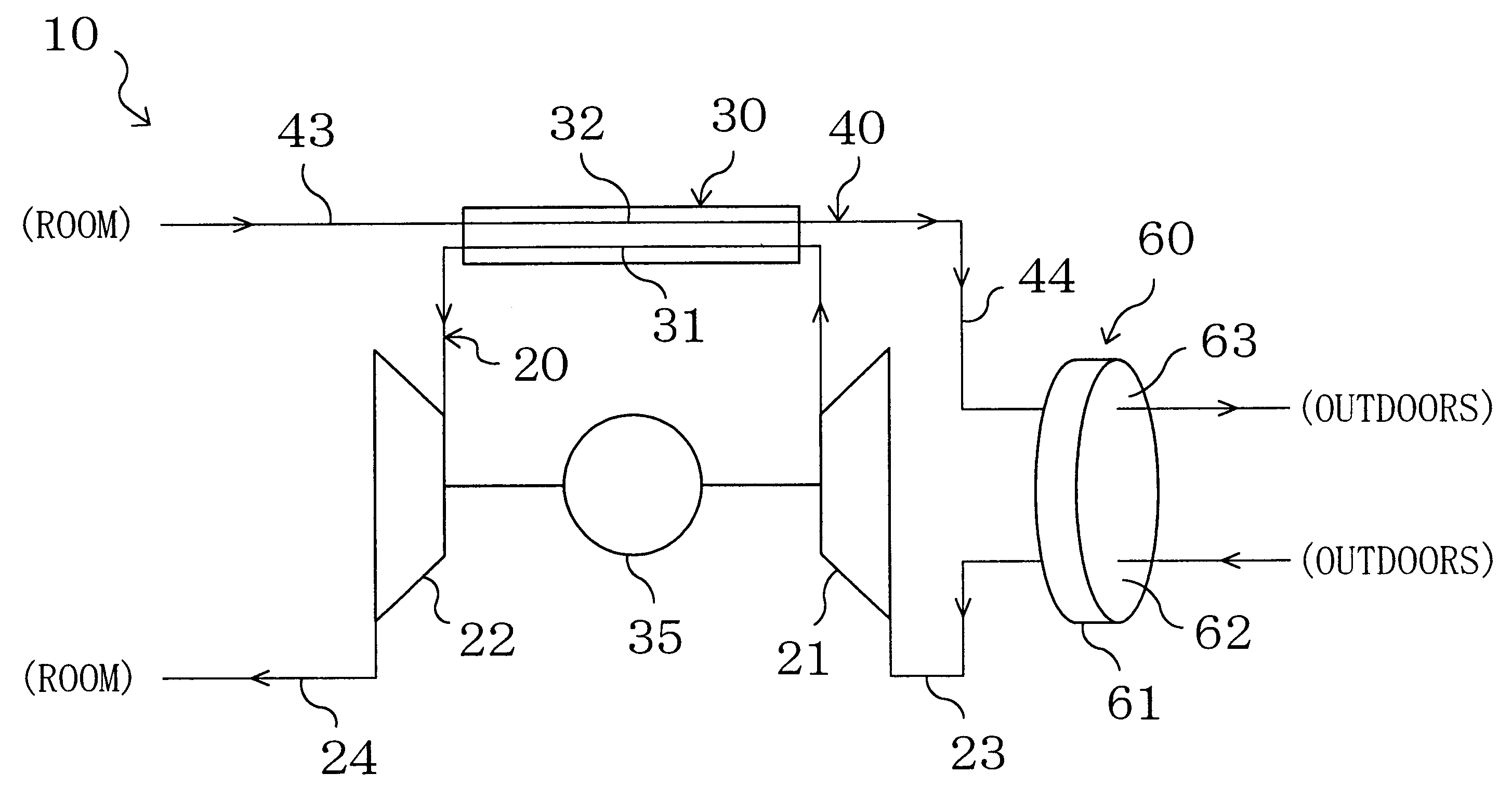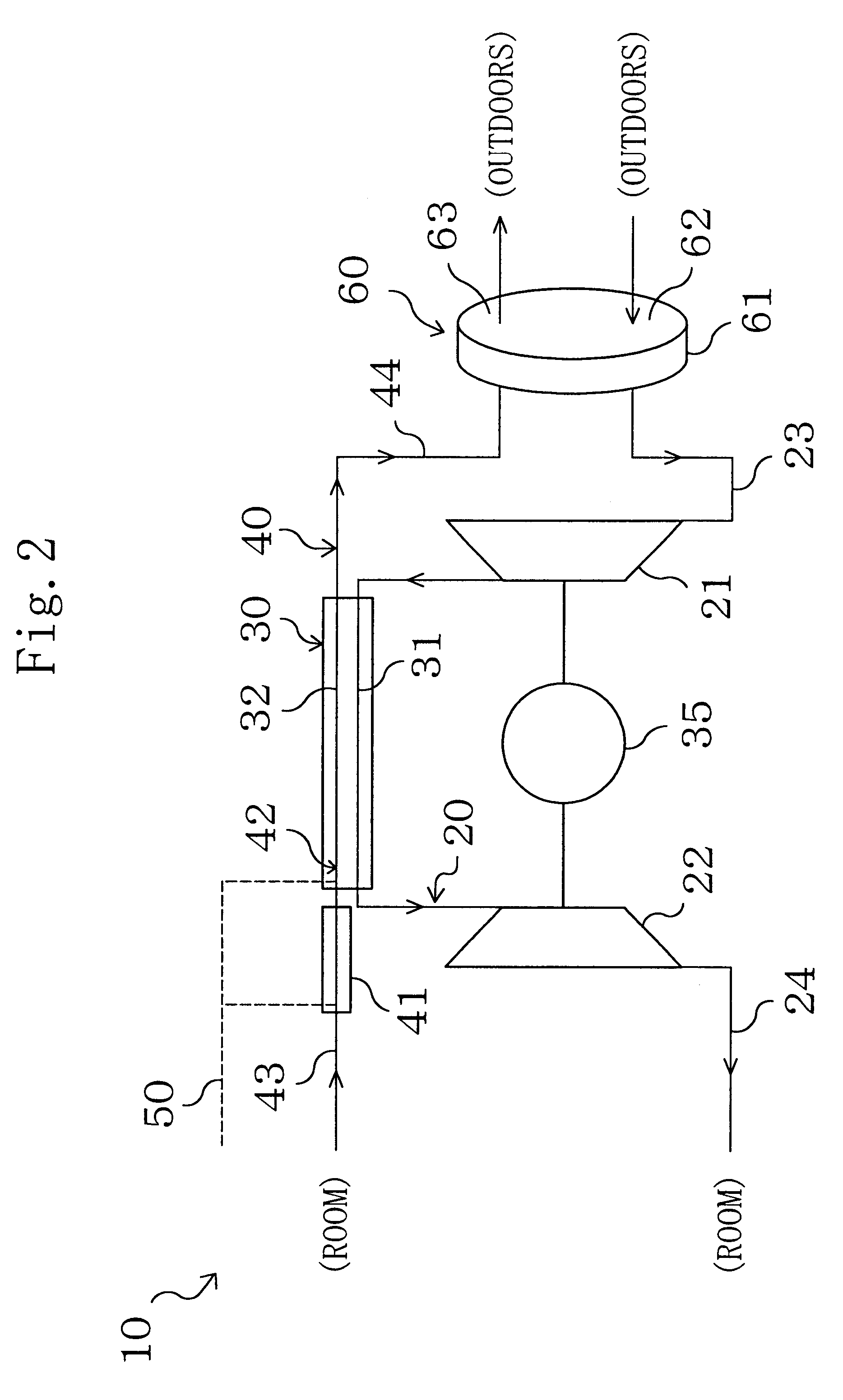Air conditioning system
- Summary
- Abstract
- Description
- Claims
- Application Information
AI Technical Summary
Benefits of technology
Problems solved by technology
Method used
Image
Examples
embodiment 1
Effects of Embodiment 1
According to Embodiment 1, moisture is adsorbed on or desorbed from the solid adsorbent of the rotor member (61) based on the difference in relative humidity between the primary and secondary airs. This implements dehumidification of the primary air. Therefore, dehumidification of the primary air is not limited to after it has been compressed by the compressor (21), unlike the case of dehumidifying it using the conventional vapor isolating membrane, and is possible also before it is supplied to the compressor (21). As a result, layout constraints of the dehumidifying mechanism (60) can be reduced, which enhances the design flexibility.
Further, since there is no need for such dehumidification between the compressor (21) and the expander (22) as conventionally done, an easy and reliable seal is provided between the compressor (21) and the expander (22) while the construction is maintained simply. This prevents leakage of the compressed air and ensures that the e...
embodiment 2
Effects of Embodiment 2
According to Embodiment 2, the following effects can be obtained in addition to the effects of Embodiment 1.
Specifically, in this embodiment, the humidifier / cooler (41) is provided to supply moisture to the secondary air, and the secondary air is cooled therein and then supplied to the heat exchanger (30). Further, the water introducing section (42) is provided to supply moisture to the secondary air in the heat absorption side passage (32), and latent heat of evaporation of the moisture is used to cool the primary air in the heat exchanger (30). Therefore, the primary air can be cooled to a still lower temperature in the heat exchanger (30) than in the case of Embodiment 1. This makes it possible to drop the air temperature at the inlet of the expander (22) to a lower degree. As a result, this embodiment enables further reduction in the input to the compressor (21) while maintaining the refrigerating capacity and thereby provides improved COP (coefficient of ...
embodiment 3
Effects of Embodiment 3
According to Embodiment 3, the following effects can be obtained in addition to the effects of Embodiment 2.
Specifically, according to this embodiment, the temperature of the primary air at the inlet of the compressor (21) can be elevated as compared with Embodiment 2. Further, the temperature of the secondary air at the outlet of the heat exchanger (30) can be accordingly elevated. Even with the same absolute humidity, rise in temperature of the air leads to drop in relative humidity thereof. Further, in this embodiment, since the amount of moisture supplied to the secondary air in the humidifier / cooler (41) and the water introducing section (42) can be reduced, the absolute humidity of the secondary air at the outlet of the heat exchanger (30) can be lowered. Accordingly, in this embodiment, the rotor member (61) will release moisture to the secondary air higher in temperature and lower in relative humidity than that in Embodiment 2. This makes it possible t...
PUM
 Login to View More
Login to View More Abstract
Description
Claims
Application Information
 Login to View More
Login to View More - R&D
- Intellectual Property
- Life Sciences
- Materials
- Tech Scout
- Unparalleled Data Quality
- Higher Quality Content
- 60% Fewer Hallucinations
Browse by: Latest US Patents, China's latest patents, Technical Efficacy Thesaurus, Application Domain, Technology Topic, Popular Technical Reports.
© 2025 PatSnap. All rights reserved.Legal|Privacy policy|Modern Slavery Act Transparency Statement|Sitemap|About US| Contact US: help@patsnap.com



